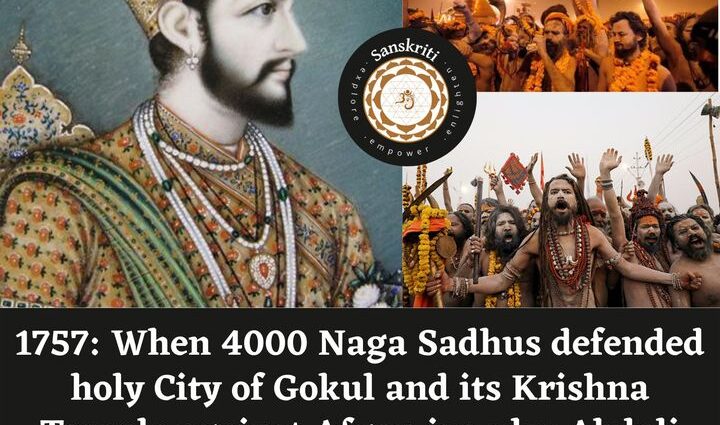Fighting traditions were always there in Sanatan Dharma. When the Adi Shankaracharya in the 8th century formed the Nagas as a Hindu army, a new martial tradition was born. Of all the Hindu akharas, the Nagas were the most militarily equipped and fierce, and their retreats are still referred to as “chhaavni,” or armed camps. They were taught to fight all the anti-Vedic invaders. They engage in mock jousts with swords, spears, and tridents, and even during a Kumbh mela, they frequently struck to kill someone in honour-related disputes as late as the 1950s.
Shankaracharya was born in Kalady, Kerala, and is said to have left home at the age of five. Adi Shankaracharya made shastra the domain of the Acharyas and astra the “ornaments” of the Nagas, after realising the necessity of both knowledge and weapons. The “winning back” of Hinduism from Buddhism was made possible in large part by these aggressive Nagas. The Dashnaam Sanyas ashrams are made up of Giris (mountain sects), Puris (from towns), Saraswatis (priests), Van-Aranyaks (forest hermits), and Sagar (seaside sects).
They could show their warrior prowess in the Battle of Gokul in 1757, in which the Afghans’ general, Sardar Khan, attacked Gokul, and around 3,000 Naga Sadhus defeated 30,000 Afghani soldiers.
At that time, Afghanistan’s Emperor Ahmed Shah Abdali was on his fourth consecutive invasion of India. The Mughals were at that point extremely weak, and there was no other Hindu power in northern India to oppose the Islamic invaders. In January 1757, he plundered Delhi, destroying many temples, but he was still unsatisfied with the loot. He gave his two Afghan commanders, Najib Khan and Jahan Khan, the order to raid Ballabgarh, Mathura, Agra, and Vrindavan with 20,000 Afghan soldiers. He added that:
The city Of Mathura, Vrindavan is a holy place of the Hindus, let it be put entirely to the edge of the sword, up to Agra leave not a single place and raze every building to the ground, whatever booties you would get in the wars will be yours, behead the Hindu Kafirs and gift their head in Afghan camp to me and take Rs 5 as a reward for that.
When the Afghan army arrived in Mathura, they began demolishing temples, raping women, beheading and chopping Hindu men into pieces, enslaving children, and forcing many women to dive into the Yamuna River to preserve their honour. A large number of Hindus sought sanctuary in the cave behind the Shitala Mata Temple, but when the Afghan soldiers discovered them there, they entered the cave with great ferocity and killed every Hindu inside. The holy ground of Mathura was saturated with Hindu blood for three days, and there were so many corpses that the city’s air was foul-smelling for months. The Afghan army enslaved 6,000 Hindu women and looted Rs 12 crore in bounty. After attacking Mathura, Afghans marched towards Vrindavan, and that too met the same fate as that of Mathura.
After destroying Vrindavan, Sardar Khan thought to plunder and loot Gokul. He, along with 10,000 Afghan soldiers, went towards Gokul, where they saw 4,000 Naga Sadhus standing for the war with them. When Naga sadhus heard about the plight caused by the Afghans on Hindus, 10,000 naga sadhus from sacred cities like Haridwar and Ujjain started gathering in Gokul but were a little late in reaching there since they were far away. A war started between the Afghan army and Naga Sadhus. At first, Afghans anticipated that the Nagas wouldn’t be able to counter them for long, but soon they were proved wrong. Afghan soldiers were overpowered by the sadhus’ military skills, who were carrying swords, matchlocks, and cannons with faces smeared in ashes. This terrified Afghan soldiers so much that they were unable to give any resistance to the Nagas at all. With heavy casualties, the Afghan army conceded defeat, and the remaining soldiers fled.
This enraged Abdali so much that he threw more troops into the war, but it was of no avail; the dead bodies of Afghan soldiers were piling up, and Afghans were losing morale. Meanwhile, other bands of nagas also entered the battlefield, which intensified the attack of the nagas. In fear of losing the war, Afghans started retreating after the order of Sardar Khan.
In this battle, 2,000 Naga soldiers achieved martyrdom while over 5,000 Afghan soldiers perished and numerous others were injured. Sardar Khan, the Afghan commander, knew that Abdali would exact revenge on him for his loss.
Numerous Hindu shrines were freed from Afghan rule by the Naga Sadhus, who were also successful in saving Gokul from their oppressive rule. Naga sadhus are real examples of bravery and faith who inspire us to defend our culture and homeland against foreign encroachment. This is the heroic history and long-standing custom of Naga Sadhus, who are unaffected by the world’s materialistic aspirations.
Now what do the Nagas do, as they were once warriors? Some of them started the Ramta Panch organisation, which brings wandering monks together and is an adherent of the Dashnam Sanyasi tradition. The Dashnami Nagas travel between Kumbhs on foot, bearing the flag of Shankaracharya and Dankas, a kind of drum, and cover thousands of villages.
They say they are still leading the charge in defending Hinduism.
—— Written by Amit Agarwal, author of the bestsellers on Indian history titled “Swift Horses Sharp Swords” and “A Never-Ending Conflict.” You may buy the books at the following link:
https://garudabooks.com/swift-horses-sharp-swords-medieval-battles-which-shook-india-hindi (Hindi)
Twitter handle: @amit1119; Instagram/Facebook: amitagarwalauthor
Featured image provided by the author inclusive of the content of the article.
- How Hindu rituals spawned numerous advancements in science, maths and other arts - March 13, 2024
- Naga Sadhus and their fighting skills - February 20, 2024
- Lessons for India from the Israel-Palestine conflict - October 12, 2023

